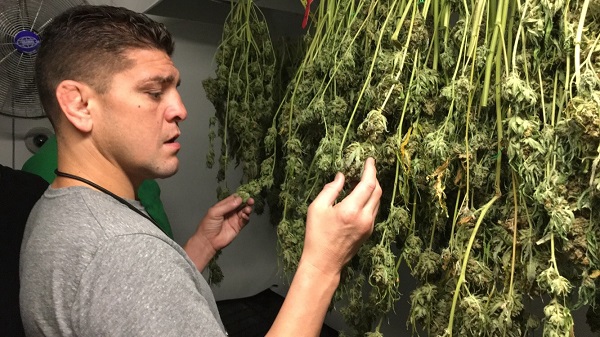Marijuana and sports of great achievements
Nick Diaz is the name well known to every fan of ultimate fighting. It is difficult to find a more ambiguous character than he, though it does not take anything away from his sporting achievements.
In 2015, Diaz led a landmark fight against Anderson Silva, the best middleweight fighter of all time. Despite the significance of the fight, the very next day it was declared failed, because the doping tests results that came by the time showed that both athletes had used doping. Silva examination results revealed the metabolite of drostanolon, an anabolic steroid, and traces of androsterone, an endogenous steroid hormone that promotes the testosterone production, in the blood of a former UFC middleweight champion.

But no steroids were found in Diaz’s doping tests… There were found only marijuana metabolites, which, however, did not prevent him from disqualifying for five years. Silva get a slap on the wrist – only 12 months of suspension for the steroids use.
It was an unprecedented case that has had no analogs to this day – never before have athletes been disqualified for such a long time even for using steroids, not to mention marijuana. Moreover, the athletic commission remained steadfast in its decision, even though Diaz had presented permission to use medical marijuana. Ross Goodman, Diaz’s lawyer, tried to challenge the Commission’s decision, appealing to the fact that marijuana itself had not been find Nick’s analysis, but there had been metabolites that had not been on the World Anti-Doping Agency’s list of illicit drugs (WADA), while WADA’s guidelines had to be followed by Athletic Commissions. The Athletic Commission did not take into account these facts and approved its own decision instead.
Why did the athletic commission awarded such a harsh sentence on the MMA star? Does the use of marijuana really provide a number of advantages in fighting, and can it affect the body better than any doping (while, unlike doping, without side effects being destructive to health)?
You are absolutely right: cannabis can well be called serious doping used by a huge number of athletes all around the world. And despite the fact that it is believed in the general public that the use of cannabis worsens coordination, slows down the reaction and negatively affects the speed of decision making, the sports of great achievements suggest the opposite. After all, where do we need perfect coordination, reactions, speed and lightning-fast decision making during a fight, if not in MMA, football, or boxing? A great number of athletes, from Mike Tyson to Nick Diaz, use marijuana, and this does not prevent them from showing all of the above, almost perfectly.
So what are these incredible advantages given by marijuana in fighting, that the Athletic Commission is so strict with?
1. Marijuana lowers the pain threshold, making it harder to knock out the athlete. The famous brothers Nick and Neith Diazs are famous in the MMA world not only as active users of marijuana, but also as the ‘concrete jaws’ of this sport. During their career, these two went through such fierce fightings, which would have been enough for another to put them away forever into the world of dreams in a minute. Diazs have never been knocked out.
2. Professional sport with its grueling workouts is a tremendous stress not only for the body, but also for the psyche. That’s why many athletes (including Diazs) are officially prescribed to use medical marijuana to recover from post-training stresses, either physical or psychological.
The endocannabinoid system is a receptor for interaction with cannabinoids entering the body. Besides, the system creates natural cannabinoids that affect physiological functions such as appetite, pain, or memory. When we train ourselves, the endocannabinoid system increases the level of cannabinoids to help the body cope with the stress associated with physical activity.
3. The use of marijuana makes it easier to withstand injuries and recover due to its anesthetic properties.
4. Marijuana accelerates fat burning, which is an extremely important task during the so-called ‘drying’ before the fight. According to a study by the American Journal of Medicine, people who consume cannabis have 16% less insulin on an empty stomach, and the level of resistance to insulin is 17% lower. All you need to know is cannabinoids help inform your body about necessity to burn sugar. Excessive sugar often leads to an increase in fat levels. That’s why, if you combine a healthy diet with cannabis and phisical exercises, you are on your way to a good mood and excellent physical condition.
Thus, marijuana is an ideal and pure natural doping.

What do you think, is it possible to become the greatest sportsman in the history of sports, being marijuana active consumer, if it slows down and leads to graying out? Of course not! But what do we see? It turns out that Michael Phelps, the only 23-times (!) Olympic champion, the absolute record holder in the number of awards (28) in the Olympic Games history, is the “malicious” lover of this natural doping.
On February 6, 2009, the USA Swimming decided to remove the 14-time (at that time) Olympic Swimming Champion, American Michael Phelps, from the competition. The reason for the removal was the conviction of the Legend in the use of marijuana.
And what if we add to Phelps another great athlete, the fastest sprinter in the history of the sports and the owner of 8 world records Usain Bolt? Yes, yes, you will probably be surprised, but Bolt is also a hardcore enthusiast of hemp. However, this is known from his own confessions, while he has never been caught by anti-doping commissions as a cannabis user. And how can you catch the fastest man on the planet?
If Michael Phelps and Usain Bolt, having used marijuana, have won all the awards in the world, then this can only say one thing: Marijuana cannot be harmful. Can you imagine an athlete who would show incredible success, consuming vodka regularly, or just smoking cigarettes? No! There are no such athletes! What to marijuana, very many current and former professional athletes admitted marijuana use (or were punished for it) during their careers. Regardless of whether they consumed it for medicinal purposes or just to have some fun, they benefited from it, and we have discussed it above. The healing properties of marijuana are invaluable, especially in stress and contact sports, such as ultimate fighting, American football, basketball, etc. In the NBA, at various times, the great Allen Iverson, Chris Webber, Jason Williams were caught with marijuana. And Larry Saunders left the league at the height of his career due to very frequent failures at marijuana tests.
Equally important is the use of marijuana for athletes who have completed a career. The clearest example of numerous health problems at the end of a sports career, and how these problems can be solved with medical cannabis, is Steve Kerr, a player of the legendary Chicago Bulls and head coach of Golden State, the National Basketball Association.
Alas, Kerr had to pay by his health for the phenomenal success in the sport, as is often the case. Professional spine problems led to the fact that in the summer of 2015, Steve Kerr underwent surgery on the spine, which was complicated by damage to the hard shell of the spinal cord and, as a consequence, the leakage of cerebro-spinal fluid. As a result, there happened the strongest migraines, nausea, pain in the cervical region, apathy. The coach was a pale shadow of himself for several months, courageously having battled against constant acute headache attack. But the worst thing was that Kerr did not know what was the matter and how long it would last. Then he got acquainted with medical marijuana for the first time. We can read the following quote about how this acquaintance turned out to be fruitful for him: “The League must study the use of marijuana as a pain killer. I’m not talking about recreational use. I’m talking about a painkiller, what’s the best for players health.”
Nowadays the strongest painkillers, like Vicodin, are often prescribed to athletes of the American professional leagues. Many people believe that these drugs are much more harmful to health than medical marijuana, and Kerr himself is among them, as you might guess: “And yet, athletes everywhere are prescribed Vicodin like it’s Vitamin C, like it’s no big deal.”
Klay Thompson, the NBA star, fully agrees with him: “…there’s obviously a medicinal side to [marijuana] that people are finding out have benefits, especially people in really high pain”, as well as Chauncey Billups:
“For medicinal use, I think we absolutely need to have that conversation. The Players Association, they need to talk about that with the NBA… because we’ve been through a ton of injuries. I’ve seen a piece on Jason Williams, who was the No. 2 pick in the draft, that talked about him being addicted to oxycontin and pain pills, and it would have been much better and much easier thing to have marijuana as a relief.”
Another example is Jake Plummer, the former player of “Arizona” and “Denver”. He says that after the end of his career he started to hate football. The game made him a millionaire and celebrity, but also rewarded him with health problems and chronic pain. “In 2012, five years after my last season in the NFL, I require microfracture surgery on both hip joints and had both labrums reattached. While on my back for weeks in recovery and rehab, I asked myself for the first time, What the hell did I play football for?“
Plummer says medical marijuana has changed his life: his pain in the joints and migraines have stopped. Now he says he is very happy that he used to play football.
In the photo, Plummer uses marijuana-based medication:

Eugene Monroe, former Jacksonville and Baltimore player, was one of the first to admit that he had used marijuana as a painkiller before he ended his career. Monroe says: The first few years that he spent in the NFL, the doctors of Jacksonville gave the players recipes for Vicodin before each match. He says he was just lucky that he did not become addicted to drugs.
“It’s a stamp on marijuana,” says Monroe. “But what’s the point of punishing a player for taking a substance that is much safer than medications that NFL doctors prescribe every day? We don’t see the NFL trying to control players’ alcohol consumption or tobacco consumption. Cannabis is less damaging, less dangerous, less addictive than both of those.”
And in the end, who can know about the anesthetic properties of marijuana for an athlete, if not the man-era Mike Tyson, who for the first time fell for using marijuana after a fight with Andrzej Gołota (Andrew Golota)? Tyson, like no one else, has felt for himself how harmful classical analgesics can be compared to marijuana. Thus, to pigeons, the children’s hobby of Iron Mike, something new was added, after the end of his sports career: it was medical marijuana. In late December 2018, Tyson acquired 16 hectares of hemp planting land in California. The legendary athlete’s initiative to create a “life-giving oasis in the middle of the desert” was warmly supported by, Jennifer Wood, the mayor of the city of California, and today’s mega-star MMA Conor MacGregor has already experienced the product of Tyson, which he did not fail to share in his instagram.
How often have you heard the statements of various sports “experts” that “Marijuana and sports of high achievements are incompatible”? And suddenly John Jones, Diazs brothers, Conor McGregor, Mike Tyson, Usain Bolt, Michael Phelps… uhh… do you still think that they are really incompatible, and marijuana can adversely affect one’s health? Or is there still more benefit from it than harm, even in sports?

